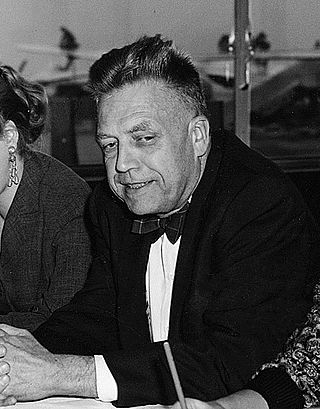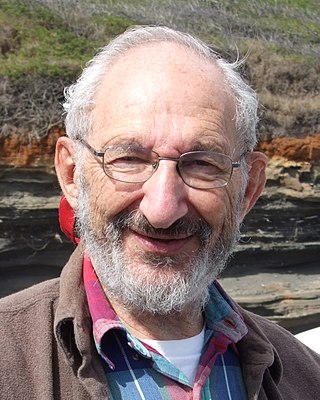Related Research Articles

The Kinsey Reports are two scholarly books on human sexual behavior, Sexual Behavior in the Human Male (1948) and Sexual Behavior in the Human Female (1953), written by Alfred Kinsey, Wardell Pomeroy, Clyde Martin, and Paul Gebhard and published by W.B. Saunders. Kinsey was a zoologist at Indiana University and the founder of the Kinsey Institute for Research in Sex, Gender, and Reproduction. Jean Brown, Cornelia Christenson, Dorothy Collins, Hedwig Leser, and Eleanor Roehr were all acknowledged as research assistants on the book's title page. Alice Field was a sex researcher, criminologist, and social scientist in New York; as a research associate for Sexual Behavior in the Human Female, she provided assistance with legal questions.

Sexology is the scientific study of human sexuality, including human sexual interests, behaviors, and functions. The term sexology does not generally refer to the non-scientific study of sexuality, such as social criticism.

Sexual orientation is an enduring personal pattern of romantic attraction or sexual attraction to persons of the opposite sex or gender, the same sex or gender, or to both sexes or more than one gender. Patterns are generally categorized under heterosexuality, homosexuality, and bisexuality, while asexuality is sometimes identified as the fourth category.

Alfred Charles Kinsey was an American sexologist, biologist, and professor of entomology and zoology who, in 1947, founded the Institute for Sex Research at Indiana University, now known as the Kinsey Institute for Research in Sex, Gender, and Reproduction. He is best known for writing Sexual Behavior in the Human Male (1948) and Sexual Behavior in the Human Female (1953), also known as the Kinsey Reports, as well as for the Kinsey scale. Kinsey's research on human sexuality, foundational to the field of sexology, provoked controversy in the 1940s and 1950s, and has continued to provoke controversy decades after his death. His work has influenced social and cultural values in the United States as well as internationally.

The Kinsey scale, also called the Heterosexual–Homosexual Rating Scale, is used in research to describe a person's sexual orientation based on one's experience or response at a given time. The scale typically ranges from 0, meaning exclusively heterosexual, to a 6, meaning exclusively homosexual. In both the male and female volumes of the Kinsey Reports, an additional grade, listed as "X", indicated "no socio-sexual contacts or reactions" (asexuality). The reports were first published in Sexual Behavior in the Human Male (1948) by Alfred Kinsey, Wardell Pomeroy, and others, and were also prominent in the complementary work Sexual Behavior in the Human Female (1953).
Judith Ann Reisman was an American conservative author, best known for her criticism and condemnation of the work and legacy of Alfred Kinsey. She has been referred to as the "founder of the modern anti-Kinsey movement". During her career, Reisman occasionally served as a consultant to the U.S. Departments of Justice, Education, and Health and Human Services. She held a Ph.D. in communications from Case Western Reserve University, and was a visiting professor of law at Liberty University.

Sexual behaviors in children are common and may range from normal and developmentally appropriate to abusive. These behaviors may include self-stimulation, interest in sex, curiosity towards sex and the opposite gender, exhibitionism, voyeurism, gender role behaviors and engagement in interpersonal sexual acts.
The Masters and Johnson research team, composed of William H. Masters and Virginia E. Johnson, pioneered research into the nature of human sexual response and the diagnosis and treatment of sexual disorders and dysfunctions from 1957 until the 1990s.

The field of psychology has extensively studied homosexuality as a human sexual orientation. The American Psychiatric Association listed homosexuality in the DSM-I in 1952, but that classification came under scrutiny in research funded by the National Institute of Mental Health. That research and subsequent studies consistently failed to produce any empirical or scientific basis for regarding homosexuality as anything other than a natural and normal sexual orientation that is a healthy and positive expression of human sexuality. As a result of this scientific research, the American Psychiatric Association removed homosexuality from the DSM-II in 1973. Upon a thorough review of the scientific data, the American Psychological Association followed in 1975 and also called on all mental health professionals to take the lead in "removing the stigma of mental illness that has long been associated" with homosexuality. In 1993, the National Association of Social Workers adopted the same position as the American Psychiatric Association and the American Psychological Association, in recognition of scientific evidence. The World Health Organization, which listed homosexuality in the ICD-9 in 1977, removed homosexuality from the ICD-10 which was endorsed by the 43rd World Health Assembly on 17 May 1990.

Milton Diamond was an American professor of anatomy and reproductive biology at the University of Hawaiʻi at Mānoa. After a career in the study of human sexuality, Diamond retired from the university in December 2009 but continued with his research and writing until retiring fully in 2018. He died on March 20, 2024, at the age of 90.
Wardell Baxter Pomeroy was an American sexologist. He was a frequent co-author with Alfred C. Kinsey.

A dysfunctional family is a family in which conflict, misbehavior, and often child neglect or abuse on the part of individual parents occur continuously and regularly. Children that grow up in such families may think such a situation is normal. Dysfunctional families are primarily a result of two adults, one typically overtly abusive and the other codependent, and may also be affected by substance abuse or other forms of addiction, or sometimes by an untreated mental illness. Parents having grown up in a dysfunctional family may over-correct or emulate their own parents. In some cases, the dominant parent will abuse or neglect their children and the other parent will not object, misleading a child to assume blame.

Child abuse is physical, sexual, emotional and/or psychological maltreatment or neglect of a child, especially by a parent or a caregiver. Child abuse may include any act or failure to act by a parent or a caregiver that results in actual or potential wrongful harm to a child and can occur in a child's home, or in organizations, schools, or communities the child interacts with.
Child-on-child sexual abuse is a form of child sexual abuse in which a prepubescent child is sexually abused by one or more other children or adolescents, and in which no adult is directly involved. While this includes when one of the children uses physical force, threats, trickery or emotional manipulation to elicit cooperation, it also can include non-coercive situations where the initiator proposes or starts a sexual act that the victim does not understand the nature of and simply goes along with, not comprehending its implications or what the consequences might be.

The relationship between the environment and sexual orientation is a subject of research. In the study of sexual orientation, some researchers distinguish environmental influences from hormonal influences, while other researchers include biological influences such as prenatal hormones as part of environmental influences.

Bisexuality is a romantic or sexual attraction or behavior toward both males and females, to more than one gender, or to both people of the same gender and different genders. It may also be defined to include romantic or sexual attraction to people regardless of their sex or gender identity, which is also known as pansexuality.
Sexualization in child beauty pageants has been the topic of controversy and debate. Since all contestants for these pageants are minors, there are concerns regarding the potential long-term impacts early sexualization can have on their psyche. These impacts can negatively affect a contestant's self-esteem and relationship with their own bodies throughout their lives due to hyperfixation on achieving professional adult aesthetics at a young age. In more extreme cases, the impacts of early sexualization in pageants can lead to various psychological disorders such as depression, anxiety disorder, and various eating disorders. However, there is also support of children competing in beauty pageants due to the way contestants are challenged to have more confidence in order to be able to compete successfully in these pageants.
Sandy Kay Wurtele is an American psychologist. She is Professor Emerita in the Department of Psychology at the University of Colorado Colorado Springs where she specialized in the prevention of childhood sexual abuse. Wurtele is the author of several educational and scholarly materials for professionals, parents, and children on preventing childhood sexual assault and abuse. Wurtele has provided training and consultation to a number of national and international organizations and researchers on this topic, including on the National Center for Missing & Exploited Children's Education Standards Task Force, the USA Swimming Safe Sport Committee, USA Wrestling, and the Roman Catholic Diocese of Wilmington.
Sexual trauma therapy is medical and psychological interventions provided to survivors of sexual violence aiming to treat their physical injuries and cope with mental trauma caused by the event. Examples of sexual violence include any acts of unwanted sexual actions like sexual harassment, groping, rape, and circulation of sexual content without consent.

In contemporary societies, the appropriateness of childhood nudity in various social situations is controversial, with many differences in behavior worldwide. Depending upon conceptions of childhood innocence and sexuality in general, societies may regard social nudity before puberty as normal, as acceptable within same-sex groups, or unacceptable.
References
- ↑ "Is Your Preschooler Playing Doctor?". FamilyEducation. Retrieved 4 September 2009. Excerpted from: Boyd, Keith M.; Osborn, Kevin (June 1997). The Complete Idiot's Guide to Parenting a Preschooler and Toddler, Too . USA: Penguin Group. ISBN 978-0-02-861733-6.
- ↑ Pike, Lynn Blinn (January 2001). "Sexuality and Your Child: For Children Ages 3 to 7". University of Missouri Extension. Archived from the original on 20 July 2012. Retrieved 4 September 2009.
- 1 2 Clayton, Victoria (6 August 2004). "Playing doctor: How to teach kids about inappropriate touch". Growing Up Healthy. NBC News. Retrieved 4 September 2009.
- ↑ Heins, Marilyn (2004). "Sex Play: parenting strategies". ParentKidsRight. Archived from the original on 14 February 2008. Retrieved 4 September 2009.
- ↑ Loseke, Donileen R.; Gelles, Richard J.; Cavanaugh, Mary M. (2005). Current Controversies on Family Violence. Thousand Oaks, CA: Sage Publications Inc. ISBN 0-7619-2106-0.[ page needed ]
- ↑ Sexual Development and Behavior in Children: Information for Parents and Caregivers (Report). American Psychological Association. 2009. doi:10.1037/e736972011-001.
- ↑ "I Caught Them Playing Doctor!". FamilyEducation. Archived from the original on 16 January 2009. Retrieved 4 September 2009. Excerpted from: Pantley, Elizabeth; Sears, William (June 1997). Perfect Parenting: The Dictionary of 1,000 Parenting Tips . McGraw-Hill. ISBN 978-0-8092-2847-8.[ page needed ]
- ↑ Kinsey, Alfred Charles; Pomeroy, Wardell Baxter; Martin, Clyde Eugene (1998). Sexual Behavior in the Human Male. Indiana University Press. ISBN 978-0-253-33412-1.